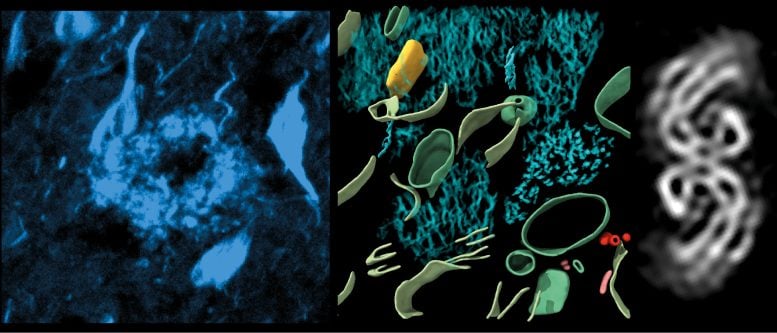Scientists have achieved a groundbreaking discovery in Alzheimer’s research by using cryo-electron tomography to map molecular structures in the human brain, focusing on beta-amyloid and tau, the main proteins linked to dementia. The study was carried out at the University of Leeds and Natureprovides insight into how these proteins inhibit brain function and could pave the way for new treatments for neurological diseases.
Groundbreaking research into Alzheimer’s disease has revealed the detailed molecular structure of a key brain protein, providing new insights into potential targeted treatments.
Scientists researching Alzheimer’s disease Disease researchers have for the first time revealed the molecular structure of a disease in the human brain. NatureWe detail how researchers used cryo-electron tomography with the aid of a fluorescence microscope to peer deep into brains donated by patients with Alzheimer’s disease.
This resulted in a 3-D map that allowed researchers to see proteins – the molecular building blocks of life – inside the brain, tiny enough that they are a million times smaller than a grain of rice. The study focused on two dementia-causing proteins: beta-amyloid, a protein that forms the microscopic, sticky plaques, and tau, another protein that in Alzheimer’s grows inside cells to form the abnormal filaments that spread throughout the brain.

Left, fluorescent image of amyloid in a cryopreserved postmortem human brain. Center, 3D molecular structure of beta-amyloid plaques. Right, tissue structure of tau filaments in a postmortem brain. Credit: University of Leeds
The study uncovered the molecular structure of tau in tissue, the arrangement of amyloid and new molecular structures intertwined with this pathology in the brain. Dementia is the leading cause of death in the UK, followed by Alzheimer’s disease.
How molecular structure impacts Alzheimer’s disease
In Alzheimer’s disease, both beta-amyloid plaques and abnormal tau filaments are thought to disrupt communication between cells, causing symptoms such as memory loss, confusion and cell death.
Lead author Dr René Frank, Associate Professor in the School of Biology at the University of Leeds, said: “This first glimpse into the molecular architecture inside the human brain not only provides further clues about what happens to proteins in Alzheimer’s disease, but also presents an experimental approach that can be applied to better understand a range of other devastating neurological disorders.”
Over the past 70 years, thousands of scientists around the world have studied proteins individually in test tubes, amassing vast catalogues of molecular structures, but we have long known that most functions in biology are the result of an orchestra of many different proteins.
The research, carried out by the University of Leeds in collaboration with scientists from the University of Amsterdam Medical College, Zeiss Microscopy and the University of Cambridge, is part of a new effort by structural biologists to study proteins directly within cells and tissues and their native environments, to investigate how proteins work together and affect each other, particularly in human cells and tissues ravaged by disease. In the long term, it is hoped that observing this interaction of proteins in tissues will accelerate the identification of new targets for the next generation of mechanism-based therapeutics and diagnostics.
Reference: “CryoET of beta-amyloid and tau in postmortem Alzheimer’s disease brains,” Madeleine A. G. Gilbert, Nayab Fatima, Joshua Jenkins, Thomas J. O’Sullivan, Andreas Schertel, Yehuda Halfon, Martin Wilkinson, Chad H. J. Mollema, Miriam Geibel, Randy J. Reid, Neil A. Ranson, Sheena E. Radford, Jeroen J. M. Hoosemans, Renée A. W. Frank, July 10, 2024, Nature.
DOI: 10.1038/s41586-024-07680-x


